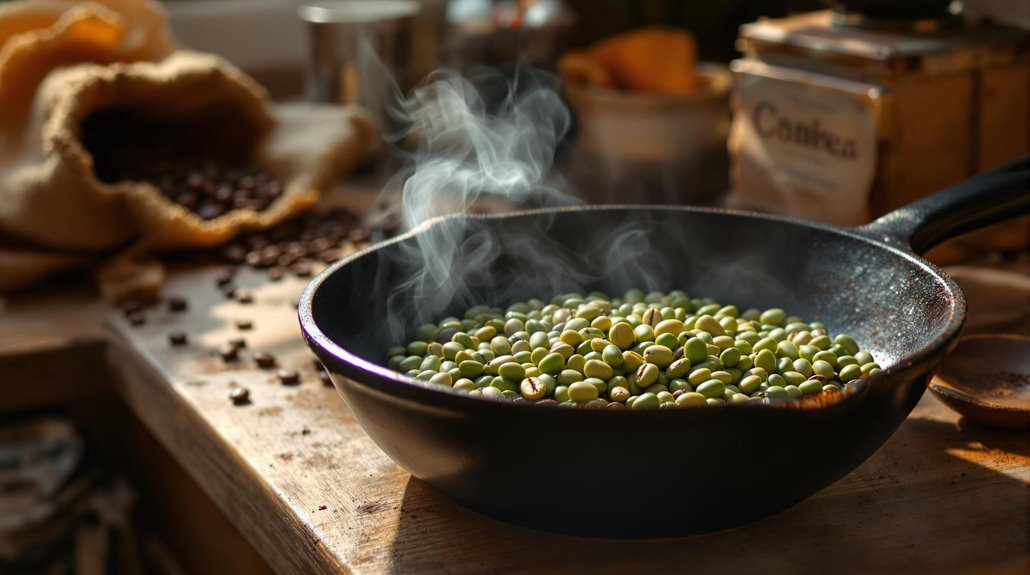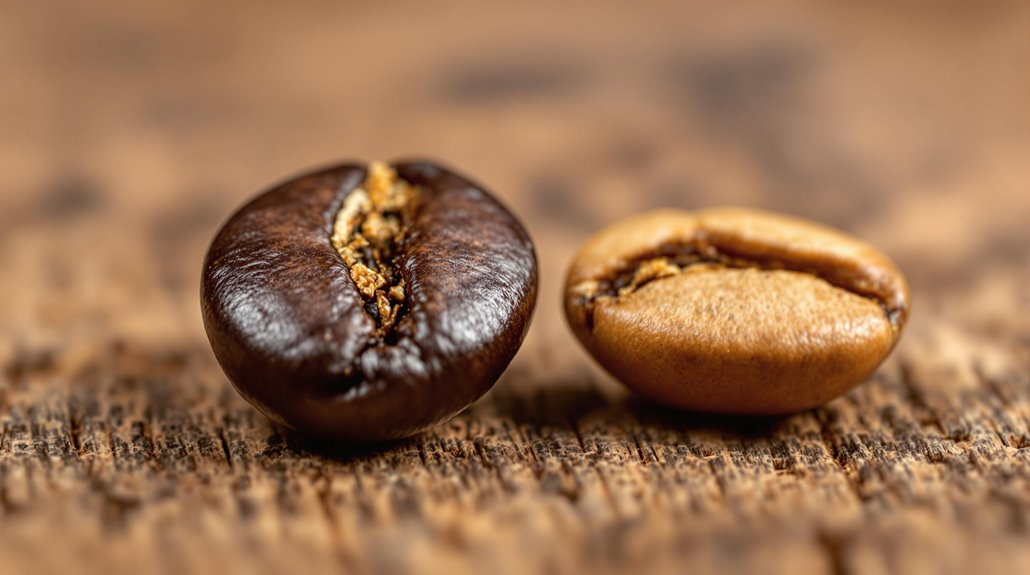




You might not realize that Arabica and Robusta coffee beans come from entirely different species of coffee plants, each with unique characteristics. Arabica beans are known for their smoother, sweeter taste, often with hints of fruit or chocolate, while Robusta packs a stronger, more bitter punch and contains nearly double the caffeine. The way they're grown also sets them apart—Arabica thrives in cooler, high-altitude regions, whereas Robusta can handle lower elevations and harsher conditions. But why does this matter for your morning cup? The answer lies in how these differences shape everything from flavor to sustainability.
Key Takeaways
- Arabica has a sweeter, smoother flavor with chocolate and fruity notes, while Robusta is stronger, harsher, and more bitter.
- Arabica contains 1.2-1.5% caffeine, while Robusta has nearly double at 2.7%, making it more pest-resistant and bitter.
- Arabica thrives at higher altitudes (600-2,000m) with cooler climates, while Robusta grows at lower elevations (200-800m) in warmer conditions.
- Arabica accounts for 60-70% of global coffee production, while Robusta makes up 30-40%, often used in blends and espresso.
- Arabica is more vulnerable to climate change and pests, while Robusta is hardier and better suited to withstand environmental challenges.
Taste and Flavor Differences
Arabica beans consistently deliver a smoother, sweeter flavor profile, often characterized by notes of chocolate, sugar, fruits, or berries, while Robusta beans exhibit a stronger, harsher, and more bitter taste with grainy or rubbery overtones. The distinct flavor profiles arise from differences in chemical composition. Arabica coffee beans contain 60% more sugars and lipids than Robusta coffee beans, which contribute to their inherent sweetness and complexity. This higher sugar content undergoes caramelization during roasting, enhancing notes of chocolate and fruit. In contrast, Robusta coffee beans have nearly double the chlorogenic acid content (7-10%) compared to Arabica (5.5-8%). Chlorogenic acids decompose during roasting into bitter compounds like quinic and caffeic acids, intensifying Robusta's inherently bitter taste. Additionally, Arabica beans possess a more delicate acidity, often perceived as bright or wine-like, whereas Robusta's acidity is sharper and less balanced. The volatile aromatic compounds in Arabica, such as ethyl acetate and isovaleric acid, further contribute to its fruity and floral notes, while Robusta's higher pyrazine content imparts earthy, woody, and nutty undertones. These biochemical variances make Arabica the preferred choice for specialty coffee, while Robusta's robust flavor profile is often used in espresso blends to enhance intensity and crema formation.
Caffeine Content Comparison
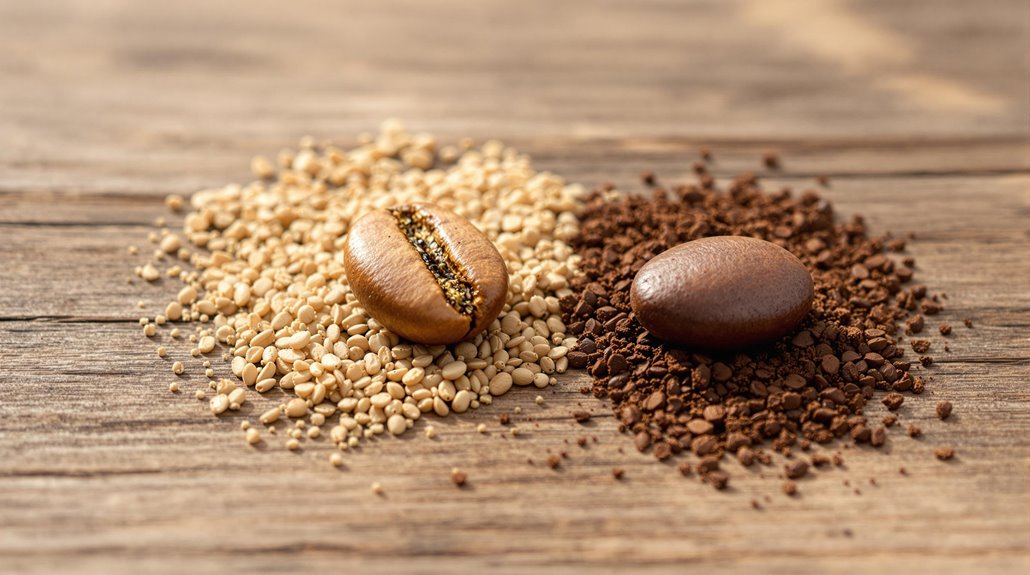
When comparing caffeine levels, Robusta beans stand out with nearly double the caffeine content of Arabica, containing 2.7% caffeine compared to Arabica's 1.2-1.5%. This significant disparity in caffeine content directly impacts the physiological and sensory properties of the beans. Robusta's higher caffeine concentration, approximately 200mg per cup, serves as a natural defense mechanism, deterring pests and enhancing the plant's resilience. In contrast, Arabica beans, with around 95mg of caffeine per cup, exhibit a milder profile, contributing to their smoother, less bitter taste. The elevated caffeine in Robusta is also associated with increased chlorogenic acid levels, which intensify its bitterness and astringency. Arabica's lower caffeine content aligns with its delicate flavor, making it preferable for specialty coffee. The biochemical differences in caffeine content between Arabica and Robusta beans are rooted in their genetic makeup, with Robusta's robust nature favoring higher caffeine production. Understanding these distinctions helps you choose beans based on desired caffeine intake and flavor preferences.
Growing Conditions and Altitude
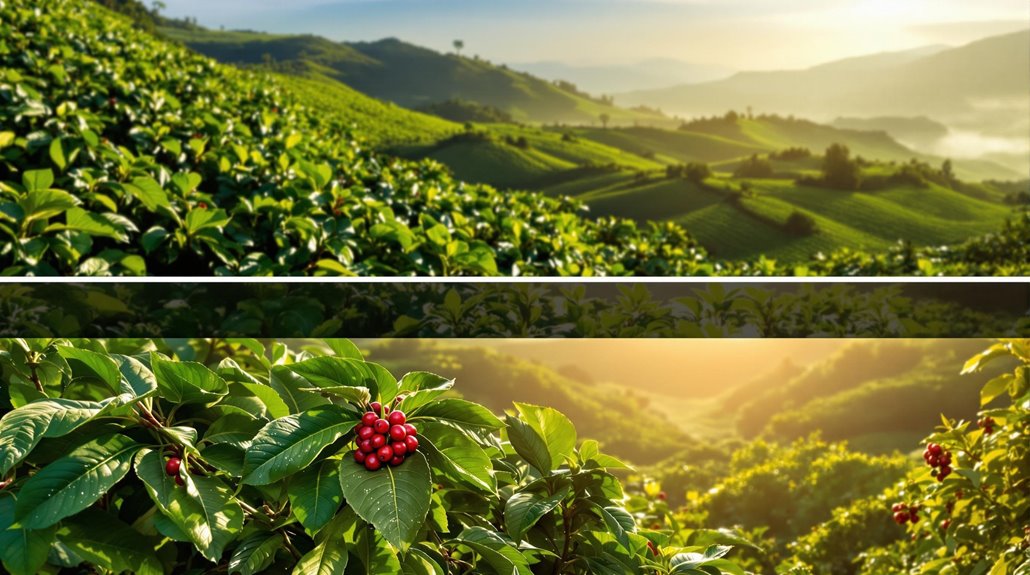
The cultivation of coffee beans is profoundly influenced by altitude and environmental conditions, shaping their growth, flavor profiles, and resilience. Arabica coffee thrives at higher altitudes, typically between 600 and 2,000 meters above sea level, where cooler temperatures and nutrient-rich soil create ideal growing conditions. These elevations slow the maturation process, allowing arabica beans to develop complex sugars and acids, which contribute to their nuanced flavors. In contrast, robusta coffee grows at lower altitudes, usually between 200 and 800 meters, where warmer climates and less fertile soils prevail. Robusta's adaptability to harsher conditions, including higher temperatures and direct sunlight, makes it more resilient but results in a faster growth cycle and a more bitter, less refined taste. The growing conditions for arabica demand meticulous care, including shade and consistent moisture, while robusta's hardiness allows for easier cultivation and higher yields. These differences in altitude and growing conditions directly influence the chemical composition of the beans, with arabica's slower development enhancing its aromatic complexity and robusta's rapid growth emphasizing its robust, earthy characteristics.
Disease and Pest Resistance

Drawing on its natural resilience, Robusta coffee exhibits superior resistance to diseases and pests compared to Arabica. Robusta's genetic makeup and higher caffeine content, ranging from 1.7% to 4%, act as a natural deterrent against pests like the coffee berry borer (Hypothenemus hampei). This pest, which burrows into coffee cherries, causes significant yield losses in Arabica crops. Additionally, Robusta's robust defense mechanisms make it less susceptible to coffee leaf rust (Hemileia vastatrix), a devastating fungal pathogen that thrives in humid conditions. Arabica, with its lower caffeine levels and genetic predisposition, is highly vulnerable to this disease, often requiring extensive fungicide applications and management practices to mitigate outbreaks.
Robusta's hardiness extends to its ability to thrive in diverse environments, reducing the need for chemical interventions. In contrast, Arabica's susceptibility to coffee leaf rust and other pathogens necessitates meticulous care, increasing cultivation costs and labor. Studies have shown that Robusta's resistance traits are linked to its evolutionary adaptation to lower altitudes and harsher climates, where pests and diseases are more prevalent. This inherent resilience makes Robusta a more sustainable option for growers in regions prone to disease outbreaks or pest infestations.
Cultivation and Harvesting Methods
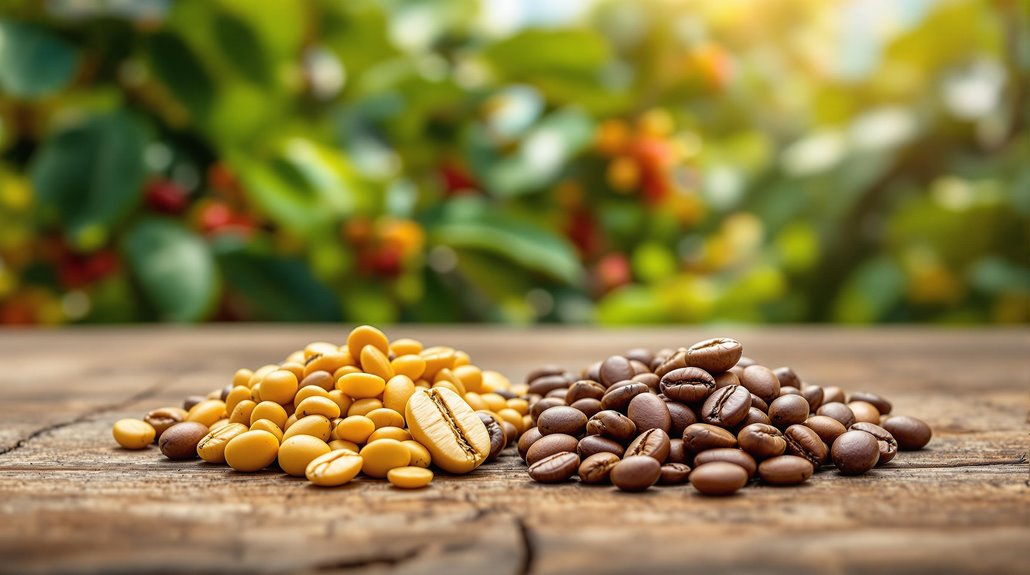
You'll find Arabica coffee cultivated at elevations of 600-2,000 meters, where cooler subtropical climates and nutrient-rich soils support its growth, though it's prone to pests like coffee leaf rust. In contrast, Robusta thrives at lower altitudes (200-800 meters), tolerating higher temperatures and exhibiting greater resistance to diseases, which reduces the need for chemical interventions. While Arabica's uneven ripening demands labor-intensive hand-picking, Robusta's uniform cherry maturation allows for efficient mechanical harvesting, making it a more cost-effective crop.
Altitude and Climate Requirements
Arabica coffee plants flourish at elevations between 1,300 and 1,500 meters, where cooler temperatures and consistent climatic conditions optimize their flavor development. These altitudes provide a diurnal temperature range of 15–24°C and annual rainfall of 1.0–1.5 meters, essential for the slow maturation of Arabica beans. This prolonged growth period allows the accumulation of sugars and acids, contributing to their nuanced flavor profile. In contrast, the robusta coffee plant thrives at lower elevations, often below 800 meters above sea level, and adapts to warmer, humid subtropical climates. Its ability to withstand higher temperatures (24–30°C) and variable rainfall makes it more resilient and easier to cultivate in diverse environments. Arabica's sensitivity to climate necessitates shade-grown methods to protect it from direct sunlight, while robusta's hardiness allows it to flourish in full sun. The differences in altitude and climate directly influence the physiological development of the beans, with Arabica's slower growth at higher elevations enhancing flavor complexity, whereas robusta's rapid growth at lower altitudes results in a stronger, more bitter taste. These distinct requirements substantially impact cultivation practices and bean characteristics.
Pest and Disease Resistance
Resilience in coffee cultivation often hinges on a plant's ability to withstand pests and diseases, a factor that substantially influences both yield and quality. Robusta coffee plants exhibit superior resistance to pests and diseases, such as coffee leaf rust and coffee berry disease, due to their higher caffeine content and elevated levels of chlorogenic acid. These compounds act as natural chemical defenses, deterring insects and fungal pathogens. In contrast, Arabica coffee plants are more susceptible to these threats, requiring intensive care and often incurring higher cultivation costs. Robusta's hardiness allows it to thrive in lower-altitude, humid environments where pests are more prevalent, reducing the need for chemical interventions like pesticides. Arabica's vulnerability has spurred the development of disease-resistant hybrid varieties, such as Catimor, which incorporate Robusta genetics to enhance resilience. While Robusta's robust chemical defense mechanisms make it a low-maintenance option, Arabica's delicate nature demands meticulous management to mitigate disease risks. Understanding these differences helps you appreciate why Robusta is often favored in regions with high pest pressure, while Arabica remains a premium choice despite its susceptibility.
Harvesting Techniques and Labor
When it comes to harvesting coffee, the techniques employed are heavily influenced by the inherent characteristics of the bean variety. Arabica beans, known for their delicate nature, ripen unevenly, necessitating selective hand-picking to guarantee only fully ripe cherries are harvested. This labor-intensive process often requires multiple passes through the same trees over several weeks, as unripe or overripe cherries can compromise the quality of the final product. The careful handling of Arabica cherries is critical to avoid damaging the fruit or the plant, which can impact yield and flavor profiles.
In contrast, Robusta beans ripen uniformly, allowing for more efficient harvesting methods such as mechanical stripping or strip-picking. This simultaneous ripening reduces labor costs and increases scalability, making Robusta a more cost-effective option for large-scale farming operations. While these methods are less precise than hand-picking, they align with Robusta's hardier nature and lower susceptibility to damage during harvesting. The differences in harvesting techniques between Arabica and Robusta highlight the trade-offs between quality and efficiency, shaped by the biological and structural distinctions of each coffee variety.
Bean Shape and Physical Characteristics
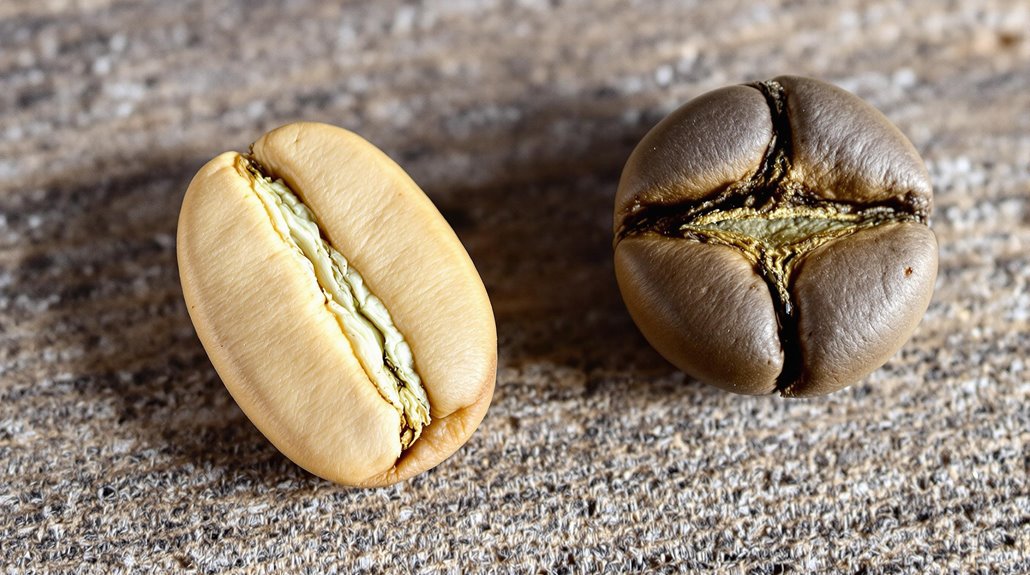
While examining coffee beans, you'll notice distinct physical differences between Arabica and Robusta varieties. Arabica beans are typically oval-shaped, with a pronounced central crease and a curved split line, giving them a more elongated appearance. In contrast, Robusta beans are rounder, with a straighter split line and a less defined crease, making them appear stouter and more compact. These shape variations are influenced by genetic differences and growing conditions, which affect the beans' development. Arabica beans are generally larger, while Robusta beans are smaller and denser. The oval shape of Arabica beans is often associated with their higher elevation growth, which results in slower maturation and a more refined structure. Robusta beans, grown at lower elevations, develop a rounder shape due to their faster growth cycle. These physical characteristics not only help distinguish the two species but also influence their processing and roasting behaviors. By observing these traits, you can identify whether you're handling Arabica or Robusta beans, even before considering their chemical composition or flavor profiles.
Chemical Composition and Antioxidants
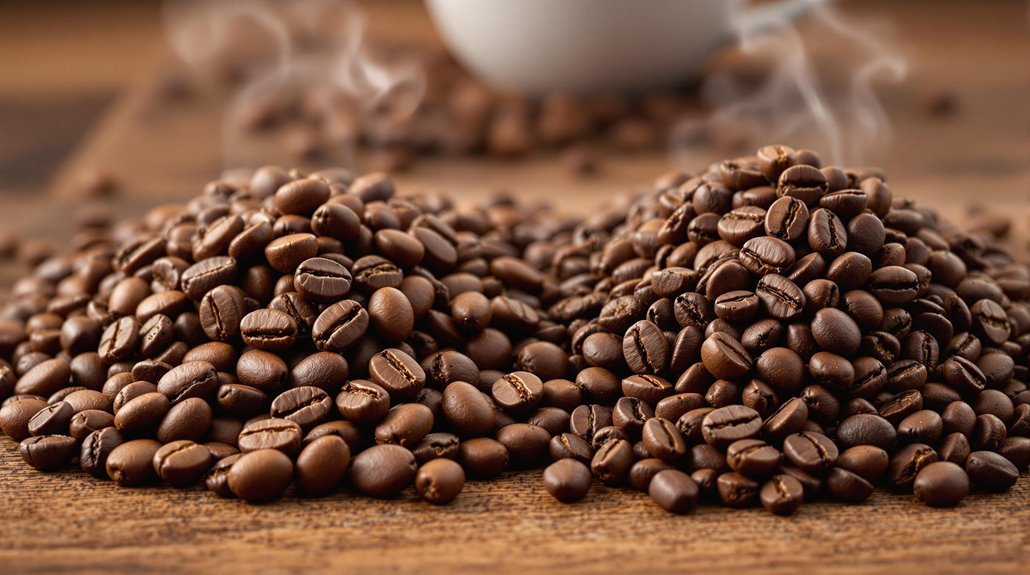
The chemical composition of Arabica and Robusta coffee beans substantially influences their flavor profiles, caffeine content, and potential health benefits. Arabica beans contain less caffeine, typically ranging from 1.2-1.5%, compared to Robusta's higher levels of up to 2.7%. This disparity in caffeine concentration contributes to Robusta's more intense, bitter taste, while Arabica's lower caffeine content aligns with its smoother, more nuanced flavor. Additionally, Robusta boasts a higher concentration of chlorogenic acids (CGA), ranging from 7-10%, compared to Arabica's 5.5-8%. These chlorogenic acids act as potent antioxidants, which may enhance Robusta's health benefits, such as reducing oxidative stress and inflammation. Arabica, however, contains 60% more lipids and nearly double the sugar concentration, which not only softens its acidity but also enhances its aromatic complexity. The elevated CGA levels in Robusta also contribute to its earthy, harsher taste profile, while Arabica's chemical composition favors a sweeter, more balanced cup. Understanding these differences in chemical composition and antioxidants helps you appreciate how each bean type impacts flavor, caffeine intensity, and potential wellness advantages.
Market Usage and Price Differences
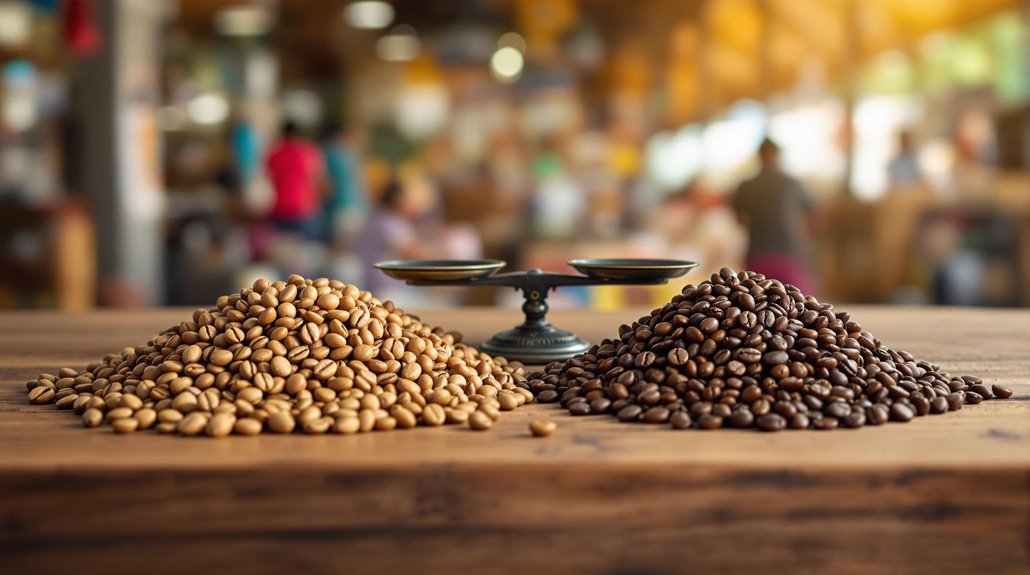
You'll find Robusta green beans priced at roughly half the cost of Arabica, making them a cost-effective option for large-scale production and instant coffee formulations. Arabica dominates the specialty coffee market, commanding higher prices due to its perceived superior quality and prevalence in single-origin offerings. While Robusta is often blended into espresso for its crema-enhancing properties, its lower market share in premium segments reflects its limited association with high-end coffee experiences.
Cost and Market Value
Priced substantially lower than Arabica, Robusta green beans typically cost about half as much on the commodity market, a disparity driven by its higher yield per hectare and reduced cultivation expenses. Robusta's cost efficiency stems from its resilience to pests and diseases, which minimizes the need for pesticides and labor-intensive farming practices. In contrast, Arabica requires meticulous care, higher altitudes, and specific climatic conditions, increasing its production costs. On the commodity market, Arabica often trades at $2.00-$3.00 per pound, while Robusta hovers around $1.00-$1.50. The market value of Arabica is further elevated in the specialty coffee sector, where high-quality single-origin beans can fetch $5.00 or more per pound. Robusta, despite its lower cost, rarely achieves such premiums, though high-grade varieties can compete with lower-end Arabica in flavor profiles. The cost differential also influences market usage, with Robusta frequently employed in instant coffee and commercial blends to reduce expenses. Arabica's higher market value reflects its dominance in the specialty and single-origin markets, where consumers prioritize nuanced flavors and quality over cost.
Usage in Coffee Blends
When blending coffee, Robusta often steps in to bolster espresso blends, contributing to a thicker crema and a more pronounced, bitter flavor profile. Coffee roasters frequently use Robusta to enhance the body and caffeine content of their blends, making it a staple in traditional Italian-style espresso. Its higher chlorogenic acid content not only intensifies bitterness but also stabilizes crema, a key visual and textural element in espresso. Arabica, on the other hand, is favored for its nuanced acidity, floral notes, and sweeter undertones, making it the go-to type of coffee for specialty and single-origin offerings. By combining these two varieties of coffee, roasters achieve a balance between cost-effectiveness and flavor complexity. Robusta's lower price point allows for more affordable blends without sacrificing the robust characteristics it brings, while Arabica elevates the overall sensory experience. This strategic blending caters to diverse consumer preferences, from those seeking bold, high-caffeine espresso blends to those desiring the refined, aromatic profiles of premium Arabica. The interplay between these beans underscores the versatility and economic dynamics of coffee production.
Global Production and Economic Impact
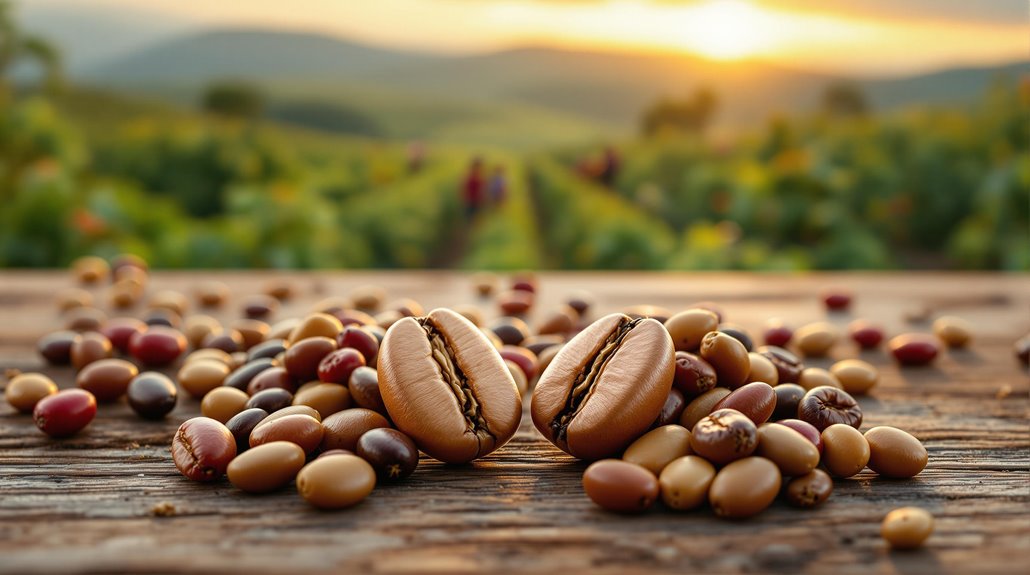
Across the spectrum of global coffee production, Arabica and Robusta beans dominate the market, with Arabica accounting for 60-70% of output and Robusta making up the remaining 30-40%. Brazil leads Arabica production, contributing over 40% of the world's supply, while Vietnam dominates Robusta, producing nearly 40% globally. Arabica's superior flavor profile and labor-intensive cultivation drive its higher market value, often commanding premium prices in the specialty coffee sector. In contrast, Robusta's lower cost and higher caffeine content make it a staple for blends and instant coffee. The global coffee market, valued at over $100 billion, heavily relies on these two species, with Arabica's economic impact tied to its quality-driven demand. However, climate change threatens Arabica's future, with studies projecting a 50% yield reduction by 2050 due to rising temperatures and shifting weather patterns. Robusta, with its greater resilience to heat and pests, may become increasingly essential as a buffer against these challenges. This dynamic underscores the economic interdependence of Arabica and Robusta in sustaining global coffee production amidst environmental pressures.
Environmental Adaptability and Threats
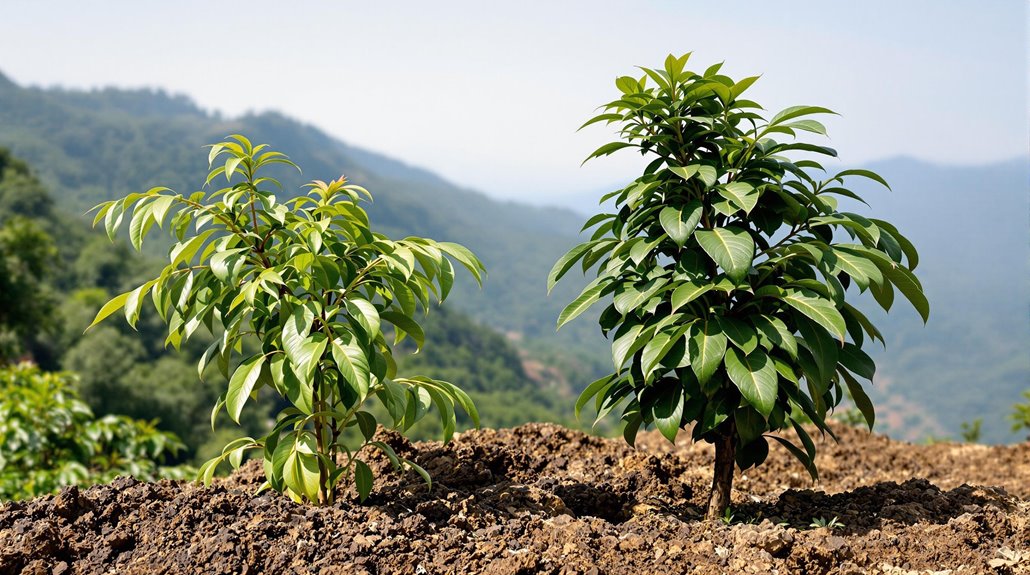
Arabica and Robusta coffee beans exhibit distinct environmental adaptability, shaped by their evolutionary histories and physiological traits. Arabica thrives in cooler, high-altitude environments (600-2000 meters), where it benefits from stable temperatures and ample rainfall. However, its sensitivity to environmental conditions makes it vulnerable to climate change, with projections suggesting wild populations could decline by 50-80% by 2088. Arabica is also highly susceptible to diseases like coffee leaf rust and pests, requiring intensive cultivation practices that further strain its resilience. In contrast, Robusta adapts to warmer, lower-altitude regions (200-800 meters) and demonstrates greater tolerance to fluctuating environmental conditions. Its natural resistance to pests and diseases enhances its hardiness, making it less reliant on human intervention. While climate change poses a significant threat to Arabica, Robusta's broader adaptability reduces its vulnerability. Deforestation in Ethiopia, where Arabica is endemic, further threatens its genetic diversity, whereas Robusta's wider geographic distribution buffers it against habitat loss. These differences highlight how environmental conditions and climate change disproportionately impact Arabica, underscoring the need for conservation and sustainable practices to safeguard its future.
Disclosure: As an Amazon Associate, I earn from qualifying purchases.

